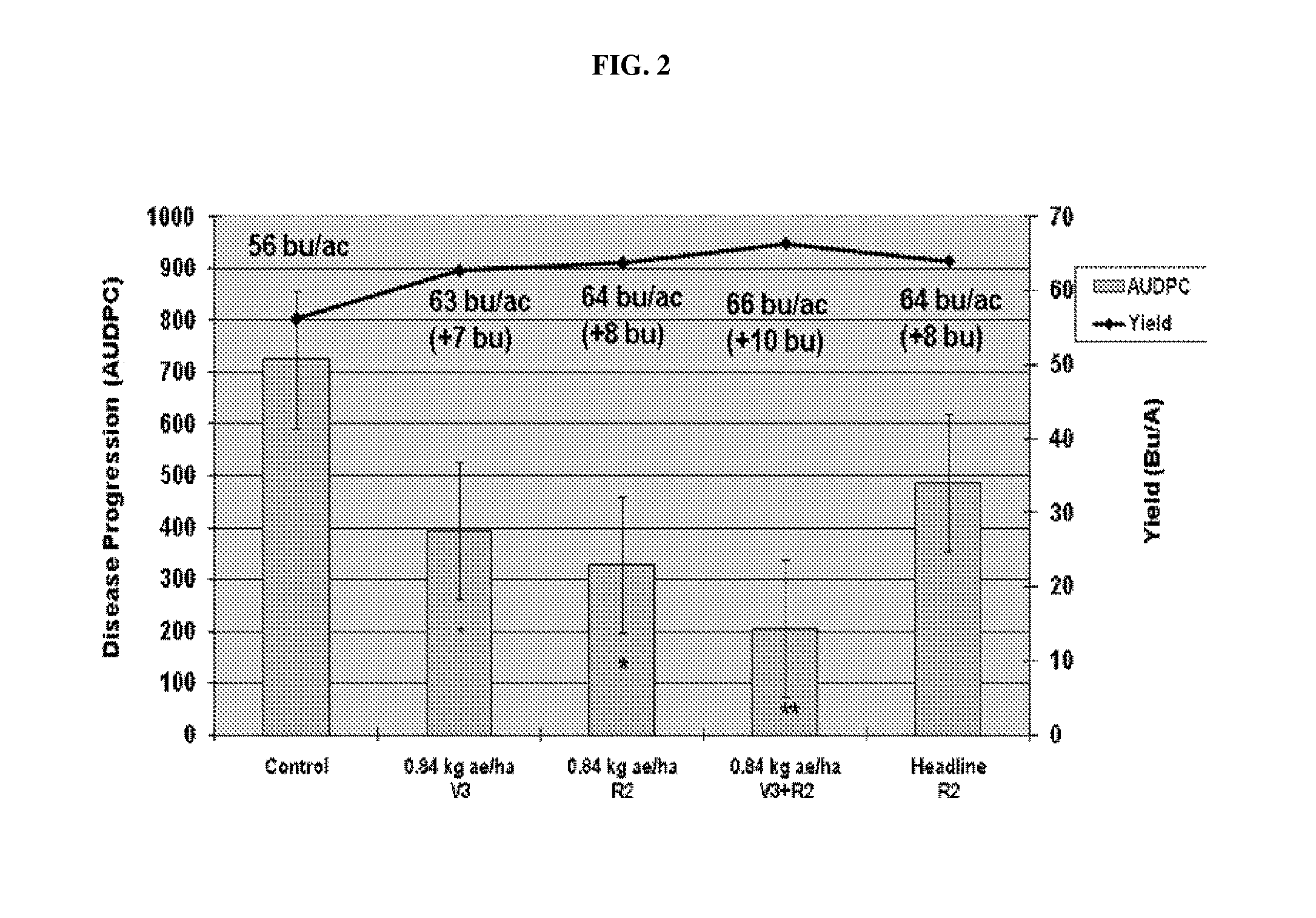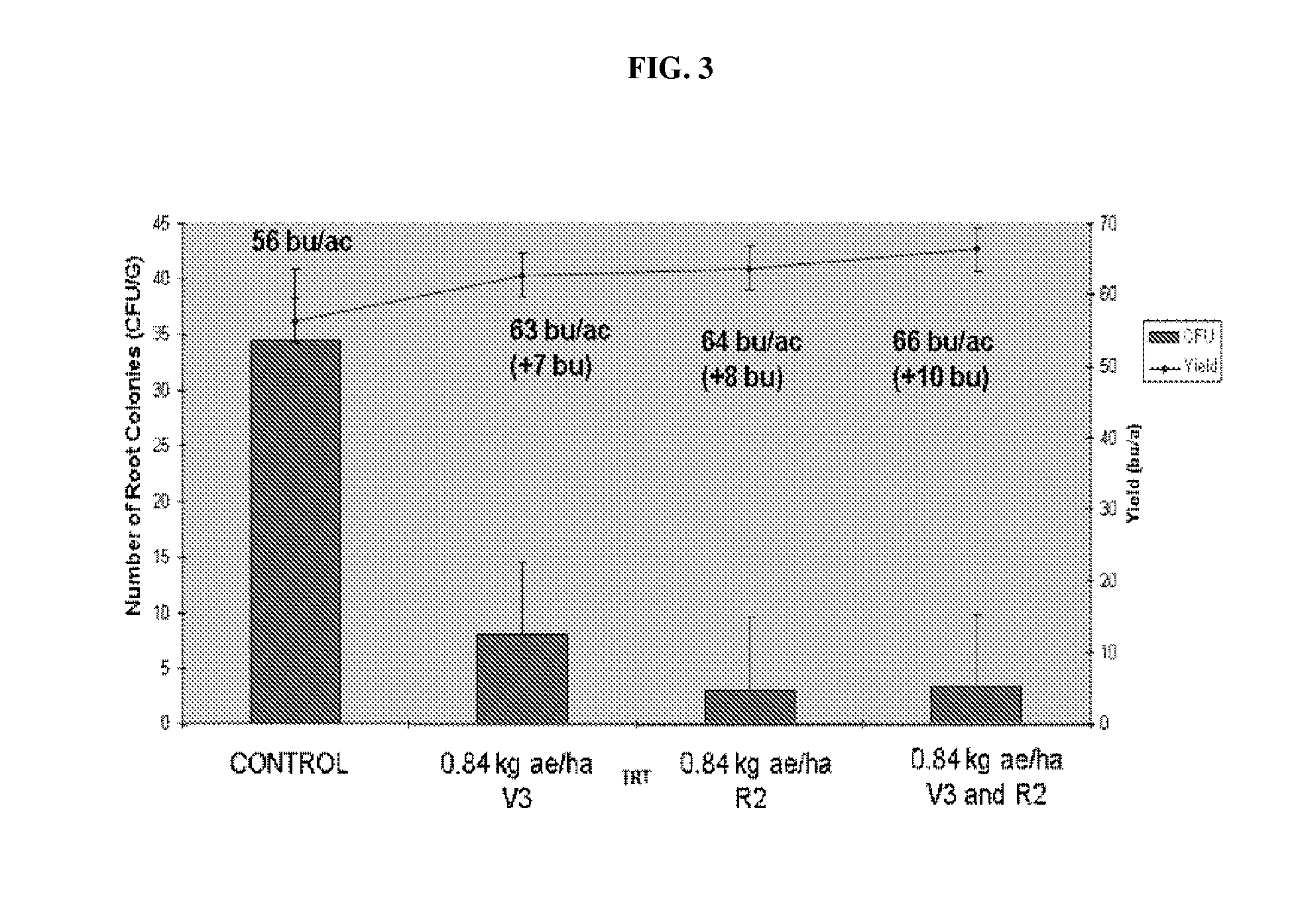Use of glyphosate for disease suppression and yield enhancement in soybean
a technology of glyphosate and soybean, applied in the direction of phosphorous compound active ingredients, biocide, fungicides, etc., can solve the problems of reducing affecting the yield of soybeans,
- Summary
- Abstract
- Description
- Claims
- Application Information
AI Technical Summary
Benefits of technology
Problems solved by technology
Method used
Image
Examples
example 1
Glyphosate Mode of Action Against Plant Pathogenic Fungi
[0087]A gene encoding EPSPS was cloned from a representative phytopathogenic fungus, in this case, from Phakopsora pachyrhizi, the causal agent of Asian Soybean Rust (“ASR”), and expressed in an Escherichia coli strain lacking the native bacterial E. coli EPSPS. Thus, EPSPS activity in the recombinant bacterial strain was due to the presence of the fungal EPSPS. Glyphosate was added to a filter paper disk and placed on a culture plate seeded with the recombinant E. coli cells, allowing for detection of a zone of growth inhibition of bacterial cells. As shown in FIG. 1, addition of glyphosate to a filter disk placed on a culture plate containing growth medium and seeded with E. coli comprising a gene encoding the fungal EPSPS resulted in a zone of growth inhibition on the culture plate. Addition of 5 mg of glyphosate to the filter paper disk resulted in a zone of inhibition of about 24 mm, while addition of 20 mg of glyphosate t...
example 2
Mobilization of Glyphosate in Planta
[0088]Mobilization of glyphosate in planta was studied to determine the potential to impact on activity against plant diseases. About 1 day after foliar application of glyphosate about 70% of the applied glyphosate may be found on the leaf surface, where it may directly contact fungal spores or infective structures, inhibiting their growth, and killing them. About 21% of the glyphosate was found localized within the foliage where it can act to inhibit infection locally. About 9% of the applied glyphosate was transported out of the treated leaf and detected systemically (e.g. in stems and roots) at the time of testing (e.g. Feng et al. 2005). The transported fraction of applied glyphosate increases to about 40% over time, further increasing systemic fungicidal activity.
example 3
Activity of Glyphosate for Treatment or Prevention of Soybean Sudden Death Syndrome
[0089]For studies relating to prevention or treatment of Soybean Sudden Death Syndrome (SDS), research plots were treated with pre-emergence herbicides prior to planting and hand weeding to remove weed pressure. Asgrow soybean cv. 4403 plots were inoculated at growth stage V3 (6 replications) with F. virguliformae and maintained weed free with INTRRO® (active ingredient: alachlor; Monsanto, St. Louis, Mo.) and FirstRate® (active ingredient: cloransulam-methyl; Dow AgroSciences, Indianapolis, Ind.) at recommended rates for Roundup Ready® Soybeans. As shown in FIGS. 2-3, disease progression as measured by AUDPC, number of root colonies (as measured by CFU / g of plant material), and yield (bushels / acre) were favorably impacted at a statistically significant level by Roundup WeatherMAX® treatment. For instance, AUDPC declined by more than half and the number of root colonies declined by as much as about te...
PUM
| Property | Measurement | Unit |
|---|---|---|
| pressure | aaaaa | aaaaa |
| risk threshold analysis | aaaaa | aaaaa |
| time | aaaaa | aaaaa |
Abstract
Description
Claims
Application Information
 Login to View More
Login to View More - R&D
- Intellectual Property
- Life Sciences
- Materials
- Tech Scout
- Unparalleled Data Quality
- Higher Quality Content
- 60% Fewer Hallucinations
Browse by: Latest US Patents, China's latest patents, Technical Efficacy Thesaurus, Application Domain, Technology Topic, Popular Technical Reports.
© 2025 PatSnap. All rights reserved.Legal|Privacy policy|Modern Slavery Act Transparency Statement|Sitemap|About US| Contact US: help@patsnap.com



